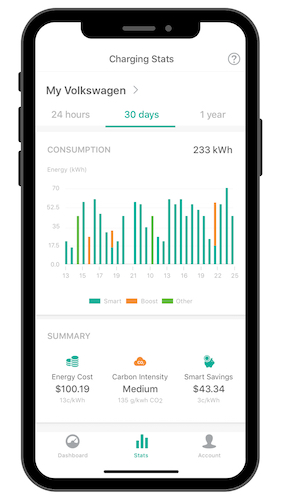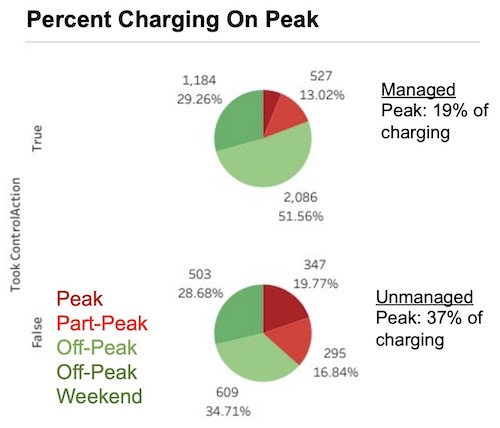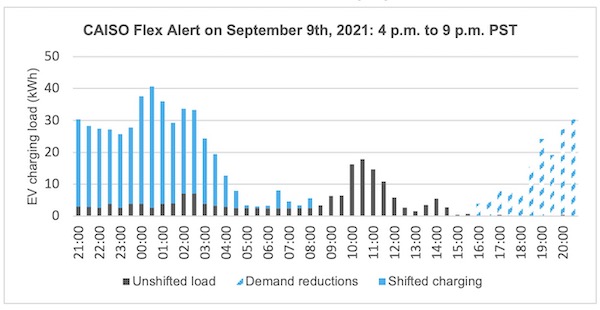About four years ago I was talking with Peninsula Clean Energy CEO Jan Pepper when she remarked that the electricity provider would like to manage the scheduling of its customers’ EV charging. I may have looked a little skeptical. Certainly in my mind I was thinking “Hey, hands off my charger!” She hastened to say that it was a little ways in the future.
Well, the future is now and I have come around to the idea, which is referred to as “managed charging”. Power providers across California are offering customers the ability to earn money by ceding control of when exactly their EV is going to charge. When customers opt in, the agencies are able to shape EV charging demand in a way that reduces peaks, saves cost, and eliminates emissions.
Managed charging is also a convenience for EV owners, who do not have to worry about timing their charges for best time-of-use rates or pre-charging before power shutoffs or flex alerts. This can happen automatically. All the owner needs to do is specify when their EV should be ready to go and then plug in as feasible. If a driver has set a 7 am ready time but needs to leave early on a long drive one day, the system is easily bypassed.

A screenshot from Silicon Valley Clean Energy’s GridShift app
There is plenty of opportunity for managed charging platforms to shape EV charging demand because EVs are generally plugged in much longer than they are actually charging. The recent pandemic and working-from-home trend has made that more true than ever. Silicon Valley Clean Energy has been operating its GridShift program for over two years, and they found that EVs were plugged in for almost 20 hours a day about a year into the pandemic, up from 12 hours in January of 2020. Since the average charging session duration they see is only 2.5 hours, there has been plenty of room for optimization. (1)
How does an EV charging application decide when to charge an EV? There are lots of different algorithms they can use and factors they can optimize for. A priority is to save customers money by charging more when energy is less expensive. A secondary priority might be to choose low-emission periods, for example preferring midday charging to midnight charging, even if both cost the same. A platform might opt to vary start times in order to smooth out the load, or to prioritize EV charging when household demand is low. Some might even be able to adjust the charging speed of vehicles so that they can charge at lower power for a longer period of time, which results in fewer peaks and valleys.
You can even imagine scheduling charging sessions to reduce transformer load. The other day I was listening to a meeting of Palo Alto’s Utility Advisory Commission, where the utility director was very concerned about the load that EV charging is putting on the city’s distribution network. The utility is having to replace undersized and overloaded transformers, each of which costs around $10,000 and can take a year to order. Utility leadership estimates they are looking at an $80 million grid modernization project that won’t be complete until 2030. If the utility were able to manage local EV charging to spread out the load from these vehicles, it would create headroom on the grid, allowing more people to electrify while network capacity is being added. In fact, there is ongoing research on managed charging algorithms that specifically aim to extend the life of transformers.
These EV charging platforms are proliferating because they have a lot of potential and little downside for users. When Peninsula Clean Energy put out a Request for Proposals recently for managed charging, they got an impressive eight bids. If you live in a region where managed charging is an option, try it out. Those of you in Silicon Valley Clean Energy’s territory can try GridShift. East Bay Community Energy has SmartCharge. Marin Clean Energy has MCE Sync. Those of you in Peninsula Clean Energy’s territory will be able to enroll in a substantial new pilot by summer. PG&E has evPulse. (2) And so on. (3)
Are users signing up? Silicon Valley Clean Energy has hundreds of happy customers enrolled in GridShift and they are excited to see more adoption as they ramp up their marketing efforts. Their staff is very enthusiastic about the GridShift program, and they estimate it has saved customers between $8 and $46 per month (!) on bills by optimizing their charging schedules. “The GridShift app helps EV drivers save on their electricity bill, charge on cleaner electricity, and avoid charging during critical grid conditions,” said Rebecca Fang, Manager of Decarbonization Programs and Policy. Bill savings are greater for customers on more differentiated time-of-use rates, like the EV-2 rate. (4) The platform now works with many types of vehicles, including Tesla, Chevrolet, Ford, and BMW, with more to come.
Silicon Valley Clean Energy recently announced special support for households with solar roofs. The application will determine when the roof is likely to be producing the most energy, based on the solar forecast, and prioritize charging during that period. It will also discourage charging during the peak period, when it is most valuable for solar customers to export their energy to the grid.
Peninsula Clean Energy’s Rafael Reyes said their small 2020 pilot was very successful, highlighting significant reductions in peak usage, which will help them reduce costs and emissions. I tried to find out from him why customers might hesitate to enroll, and he feels there is little downside. “The technology works great.” He believes the challenge is mainly explaining something new and helping people get used to it.

Results from Peninsula Clean Energy’s small managed charging pilot were encouraging.
While these platforms work best when vehicles are plugged in, they can also provide assistance even when they are not, such as when the grid is especially strained or has excess solar energy. In those events, the app can issue an alert encouraging users to plug in during certain periods. For example, the application may encourage users to charge the day before a Flex Alert or Public Safety Power Shutoff and encourage them to plug in. Silicon Valley Clean Energy has seen good success with drivers moving charging away from Flex Alert periods.

Customers enrolled in Silicon Valley Clean Energy’s GridShift program avoided charging their EV during Flex Alerts. Source: GridShift pilot report (2021)
Have you enrolled in one of these EV charging programs? Do you have any questions about them? Please share in the comments.
Notes and References
1. EVs that are plugged into standard outlets, which charge very slowly, have less room for optimization since they have much longer charging sessions. This long, low charging pattern is relatively grid-friendly.
2. PG&E has recently announced that it is launching an EV charging pilot that will incorporate two-way charging, in which a vehicle’s battery can export energy to the home or the grid when it is needed. That is a much more advanced and involved feature than the vanilla managed charging discussed in this blog post.
3. Well, Palo Alto doesn’t have smart meters, and at least one utility director recently expressed doubts that managed charging programs will be able to enroll customers. But even we Palo Alto residents can hold out hope that one day things will turn around in our city! Let the Utilities Advisory Commission know if you would like to try one of these programs!
4. These savings calculations can be tricky because they involve computing a counterfactual baseline, namely a guess of how much the users would have spent otherwise. Previous bills are a good indicator, but it’s possible charging behavior would have changed even without the app. So these are just estimates of savings.
Current Climate Data (October/November 2022)
Global impacts, US impacts, CO2 metric, Climate dashboard
Comment Guidelines
I hope that your contributions will be an important part of this blog. To keep the discussion productive, please adhere to these guidelines or your comment may be edited or removed.
- Avoid disrespectful, disparaging, snide, angry, or ad hominem comments.
- Stay fact-based and refer to reputable sources.
- Stay on topic.
- In general, maintain this as a welcoming space for all readers.



